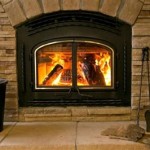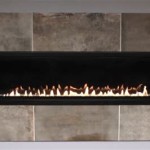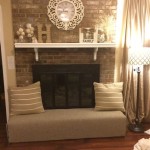Corner Two-Sided Fireplace Mantels: Enhancing Ambiance and Design
Fireplaces have long served as focal points in residential and commercial spaces, providing both warmth and aesthetic appeal. The corner two-sided fireplace, in particular, presents a unique design opportunity, offering a visual connection between two adjacent rooms. To further enhance the inherent charm of such a fireplace, a carefully chosen mantel becomes essential. This article explores the multifaceted aspects of corner two-sided fireplace mantels, examining their purpose, design considerations, material options, installation techniques, and integration with overall interior design.
A corner two-sided fireplace, also referred to as a peninsula fireplace or a see-through corner fireplace, serves to physically and visually connect two spaces. This configuration is especially advantageous in open-concept layouts, where it can define distinct areas while maintaining a sense of flow. The addition of a mantel significantly enhances the fireplace's presence, transforming it from a purely functional heating element into a design statement.
The Purpose and Functionality of a Corner Two-Sided Fireplace Mantel
A fireplace mantel serves several critical functions. Primarily, it provides a decorative element that frames the firebox and elevates the overall aesthetic appeal of the fireplace. Beyond aesthetics, the mantel offers a practical surface for displaying decorative objects, artwork, photographs, and seasonal decorations. This decorative function allows for personalization and creates opportunities to harmonize the fireplace with the overall design theme of the rooms it connects.
Moreover, the mantel can act as a heat shield, protecting vulnerable materials above the fireplace opening from excessive heat. While modern fireplaces often have built-in heat management systems, the mantel still offers an additional layer of protection, especially when the fireplace is used frequently. The specific thermal properties required of the mantel material will depend on the type of fireplace (gas, electric, or wood-burning) and the proximity of the mantel to the firebox.
Furthermore, the mantel can serve as a structural component, supporting the surrounding firebox facing material, such as stone, brick, or tile. In some installations, the mantel is integrated into the structural framework of the fireplace itself, providing crucial support and stability. This is particularly relevant in older homes or when dealing with heavier facing materials.
Design Considerations for Corner Two-Sided Fireplace Mantels
Designing a corner two-sided fireplace mantel requires careful consideration of several factors, including the size and proportions of the fireplace, the architectural style of the surrounding rooms, and the desired aesthetic effect. The mantel should be proportional to the scale of the fireplace and the rooms it connects. A mantel that is too large can overwhelm the space, while one that is too small may appear insignificant and visually unbalanced.
The architectural style of the home should also influence the design of the mantel. In a traditional setting, a mantel crafted from carved wood with intricate detailing would be appropriate. A modern or contemporary space might call for a simpler, more minimalist design, perhaps featuring clean lines and a smooth, unadorned surface. Transitional styles can incorporate elements of both traditional and modern design, offering a versatile option for a wide range of interiors.
The desired aesthetic effect should also guide the design process. A light-colored mantel can brighten a room and create a sense of spaciousness, while a dark-colored mantel can add drama and sophistication. The choice of materials, finishes, and decorative elements will all contribute to the overall aesthetic impact of the mantel.
Considering the two-sided nature of the fireplace is crucial. The mantel design should ideally be visually appealing from both rooms that it faces. This can be achieved through a symmetrical design, or through a carefully balanced asymmetrical arrangement. The sightlines from both rooms need to be considered to ensure that the mantel enhances the experience of the fireplace from every vantage point. Accessibility and functionality from both sides also play a role, especially if the mantel is used for storage or display.
Material Options and Their Properties
The selection of materials for a corner two-sided fireplace mantel is a critical decision that impacts both its aesthetic appeal and its functionality. Common material options include wood, stone, concrete, and metal, each possessing unique characteristics and advantages.
Wood is a popular choice for fireplace mantels due to its versatility, warmth, and natural beauty. Different types of wood, such as oak, maple, pine, and cherry, offer varying grain patterns, colors, and textures. Wood can be easily stained, painted, or carved to achieve a wide range of styles, from rustic to elegant. However, wood is susceptible to heat damage and requires proper sealing and maintenance to prevent warping, cracking, or discoloration. It is important to choose a hardwood species that is relatively resistant to heat and moisture.
Stone, such as marble, granite, limestone, and slate, offers a more durable and fire-resistant option for fireplace mantels. Stone mantels can add a sense of sophistication and grandeur to a room, and their natural variations in color and texture create a unique and timeless appeal. Stone is relatively easy to clean and maintain, but it can be heavy and expensive, requiring specialized installation techniques. The weight of the stone mantel needs to be carefully considered in the structural design of the fireplace.
Concrete is an increasingly popular material for modern fireplace mantels. Concrete mantels can be cast in a variety of shapes and sizes, offering a sleek and contemporary aesthetic. Concrete is also relatively durable and fire-resistant, and it can be stained or polished to achieve a variety of finishes. While heavy, concrete offers unique textural opportunities and can contribute to an industrial-chic or minimalist design. Concrete can also be susceptible to cracking if not properly sealed and maintained.
Metal, such as steel, iron, and copper, can be used to create striking and modern fireplace mantels. Metal mantels can be fabricated in a variety of shapes and sizes, and they can be finished with different coatings, such as powder coating or patinas. Metal is durable, fire-resistant, and relatively easy to clean, but it can be prone to rust or corrosion if not properly protected. The use of metal in a fireplace mantel can add a sleek, industrial edge to the design.
The choice of material also impacts the cost of the mantel. Wood is generally the most affordable option, while stone and metal tend to be more expensive. Concrete falls somewhere in between, depending on the complexity of the design and the type of finish chosen.
Installation Considerations and Techniques
Installing a corner two-sided fireplace mantel requires careful planning and execution to ensure proper fit, stability, and safety. The installation process will vary depending on the type of mantel, the construction of the fireplace, and the surrounding wall materials. It is generally advisable to consult with a qualified contractor or installer to ensure that the installation is performed correctly.
Before beginning the installation, it is essential to accurately measure the fireplace opening and the surrounding wall area. The mantel should be sized to fit snugly against the wall, with minimal gaps or overlaps. The mantel should also be positioned at the correct height, typically between 48 and 54 inches above the floor. This height provides a comfortable viewing angle and allows for easy access to the mantel surface.
The mantel must be securely attached to the wall using appropriate fasteners, such as screws, bolts, or anchors. The type of fasteners and the attachment method will depend on the weight of the mantel and the type of wall material. For heavier mantels, it may be necessary to use structural supports, such as steel brackets or wooden cleats, to provide additional stability. Securing the mantel to the framing of the wall is ideal whenever possible.
When installing a wooden mantel, it is important to leave a small gap between the mantel and the firebox opening. This gap allows for expansion and contraction of the wood due to heat and humidity, preventing warping or cracking. The gap can be filled with a fire-resistant caulk or sealant to prevent drafts or smoke from escaping. Non-combustible materials are a must around the immediate opening of any firebox.
For stone or concrete mantels, it is necessary to use specialized adhesives and anchoring systems to ensure a secure and lasting bond. These materials are heavy and require strong support. Proper leveling is crucial to prevent stress cracks or instability. It is highly recommended to engage a professional masonry contractor for the installation of stone or concrete mantels.
After the installation is complete, it is important to inspect the mantel for any signs of damage, instability, or misalignment. Any necessary adjustments or repairs should be made promptly to ensure that the mantel is safe and functional. Regularly inspect the mantel for wear and tear, especially after periods of heavy use.
The two-sided nature of the fireplace demands consideration during installation to ensure a consistent visual and structural integration with both adjacent rooms. Ensuring symmetry or a balanced asymmetry in the connection to the wall on both sides is paramount. The fasteners used must be adequate to support the mantel from both perspectives.
Integrating the Mantel with Overall Interior Design
A corner two-sided fireplace mantel should seamlessly integrate with the overall interior design of the rooms it connects. The mantel's style, color, and materials should complement the existing furniture, décor, and architectural elements. This integration creates a cohesive and harmonious aesthetic that enhances the entire space.
The color of the mantel should be chosen to complement the wall colors and other accent colors in the room. A neutral-colored mantel can blend seamlessly with any color scheme, while a bold-colored mantel can add a pop of visual interest. Consider the color temperature of the rooms; warm colors like reds and yellows create a cozy feel, while cool colors like blues and greens evoke a sense of calm.
The style of the mantel should align with the overall design style of the room. A traditional room might feature a mantel with ornate carvings and classic details, while a modern room might call for a sleek and minimalist mantel with clean lines. The mantel should serve to reinforce the design theme of the space, rather than competing with it.
The mantel can be used to display decorative objects that reflect the homeowner's personal style and interests. Artwork, photographs, candles, vases, and seasonal decorations can be arranged on the mantel to create a visually appealing and personalized display. Consider the scale and proportions of the objects, and aim for a balanced and harmonious composition.
Lighting can play a significant role in enhancing the visual appeal of the mantel. Spotlights or accent lights can be used to highlight specific features of the mantel or to illuminate displayed objects. The level of lighting should be adjusted to create the desired ambiance, from soft and romantic to bright and inviting.
The integration of the mantel into the overall interior design necessitates a holistic approach. The mantel should not be viewed as an isolated element, but rather as an integral part of the room's overall composition. Careful attention to detail and a consistent design vision are essential for achieving a successful and visually pleasing result.
In the case of a corner two-sided fireplace, it is essential that the design integration is consistent across both connected rooms. This doesn't necessarily mean identical, but rather a harmonious relationship in style, color palette, and decorative elements. The fireplace and mantel should serve as a unifying element between the two spaces, strengthening the sense of connection and flow.
Corner Two Sided Gas Fireplace Heat Glo

Vantage Hearth B Vent Gas Corner Fireplace

Terrific Photos Two Sided Corner Fireplace Style Fireplaces Offer Myriad Benefits To Folks With Gathering Roo

Fireplace Remodel With Two Sided And Cedar Tree For Mantel Corner Tile Seating

110 Best Two Sided Corner Fireplace Ideas Design

Cornerfireplaceideas Com Lareiras De Canto Lareira Casas

How To Decorate A Corner Fireplace Mantel For The Holidays Making It In Mountains

Hearth Home Technologies Corner Gas Fireplace Fireside

Vantage Hearth Direct Vent Gas Corner Fireplace

Double Corner Fireplace Modern
Related Posts








